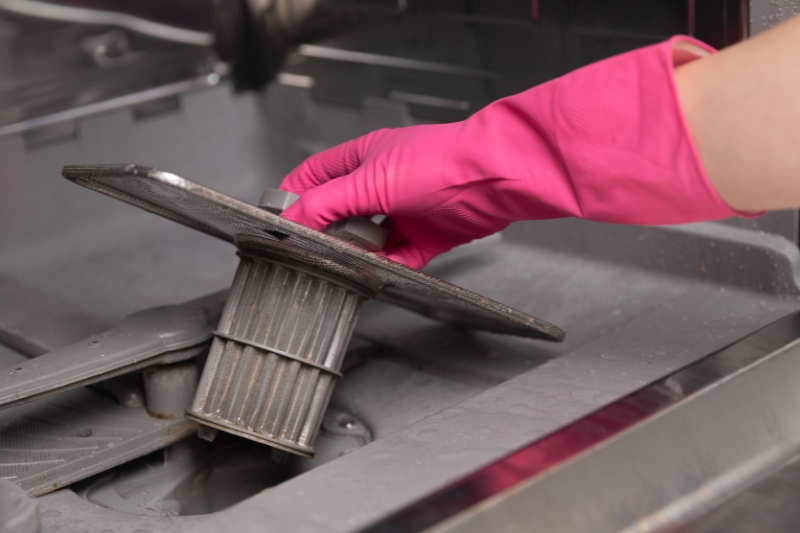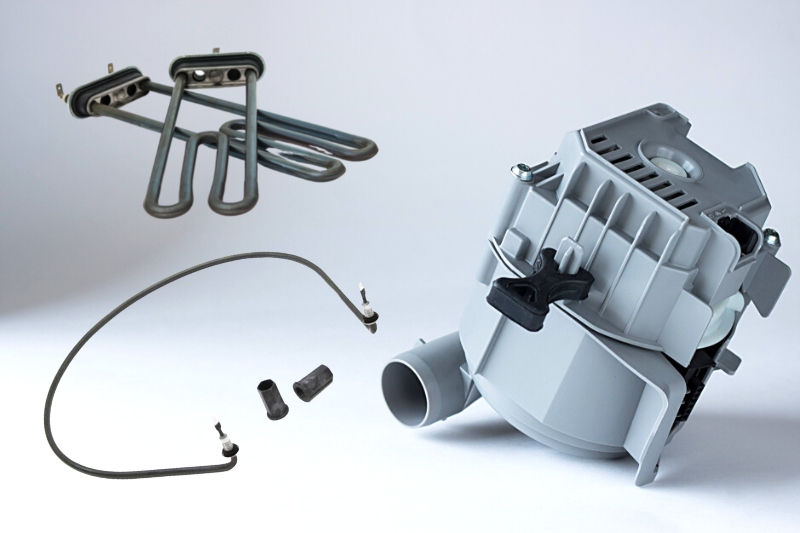If your dishwasher isn’t heating up, we’re here to help. Below, we have the common causes of why a dishwasher may not be heating up.
We’re going to start with the simplest problem to fix. And even though the other two issues are slightly more difficult to solve, anyone with some DIY and electrical knowledge shouldn’t have any problem getting their dishwasher up and running again.
Cause 1: Blocked Filter

The drain filter in your dishwasher is quite an important component. Not only does it stop food from getting into the drain, but it can also affect the entire operation of the dishwasher.
You see, if the filter gets too dirty and becomes blocked, the power of the dishwasher can be affected. As a result, your dishwasher’s ability to heat up can be impacted.
Solution: Clean the filter
Thankfully solving this issue is as simple as cleaning the filter. The dishwasher filter is located at the bottom of the dishwasher, usually in the middle, but on some models, it is located at the back to one side.
If your filter is clogged or dirty, just leave the filter to soak for about an hour in a sink full of warm, soapy water. After this, rinse it off and remove any food left on the filter.
Just before you put the filter back in, give the area around where the filter goes a wipe with a damp cloth.
Remove any food or dirt from the area, then place the filter back in. If the filter was the issue, your dishwasher should now be able to heat up just fine.
Cause 2: Faulty Thermostat
The thermostat on your dishwasher controls how hot the water gets. It monitors how warm the water is, and once it reaches the desired temperature, it tells the dishwasher to turn off the heating element.
If the dishwasher’s thermostat is faulty, it may be telling the computer to shut off the heating element too soon, and this results in the water not heating up as normal.
Solution: Replacing the thermostat
While replacing the thermostat isn’t too tricky, it can be somewhat of a pain as it is located in the bottom of the dishwasher, underneath a panel. However, removing this panel and locating the thermostat isn’t too tricky.
The thermostat is held in place with a bracket that can be popped in and out of place. By holding the thermostat firmly, you can pop the bracket out, remove the connectors for the wires, and the bracket and the thermostat should come out freely.
Now all you need to do is replace the thermostat with a new one. With the old bracket and new thermostat together, you can reconnect the wires and pop the thermostat in place.
After the panel is put back on, give the dishwasher a test. If the thermostat was the cause of the issue, it should be working perfectly now.
Cause 3: Faulty Heating Element
The heating element in a dishwasher controls a lot of what is going on. It doesn’t just heat up the water, but it is also a big part of the drying process.
While the heating element is built to last quite a long time, it can burn out and may need to be replaced.

Solution: Replace the heating element
Thankfully, just like the thermostat, the heating element is quite simple to replace if you are good with your hands.
Unfortunately, there isn’t a universal way for heating elements to be mounted into dishwashers. So sadly, we only offer a bit of help with this one.
Still, we can help you test your heating element to see if it is the cause of the issue.
Firstly, grab a multimeter and find the heating element. It is a curved bar of metal and is typically located near the drain filter we talked about earlier.
Again though, the heating elements in the dishwasher do vary. This would be a great time to find the manual for your dishwasher either in the ‘Drawer of Doom’ or online.
Once you’ve located the heating element, find the wires running to it. These should be underneath the same panel we removed when we changed the thermostat above.
Set your multimeter to ohms. You should see a reading between 15 to 30 ohms. Anything above or below this and the heating element is faulty.
Replacing the heating element is as simple as the thermostat. It is held in place with a few screws, and the connections to the wires are easy to remove.
However, as heating elements vary greatly between models of dishwashers, try and find a video online of someone replacing the same heating element as yours. That way, you’ll be able to see clearly how to do it.
In Conclusion
We hope this look at the causes of dishwashers not heating up has been helpful. If you ever get stuck repairing your dishwasher, always consult the manual and look for a video. There is likely someone who has had the same problem and has filmed themselves correcting it.
If you didn’t find the cause of your dishwasher issues above, we do have other articles going into detail about other common faults with dishwashers that you may find helpful.
We also have lists of the best dishwashers available in the UK for all budgets. Just in case your dishwasher is beyond repair.

In The Wash is your guide to the best laundry and cleaning products, tips and tricks. Our mission is to solve the UK’s cleaning and laundry dilemmas!






